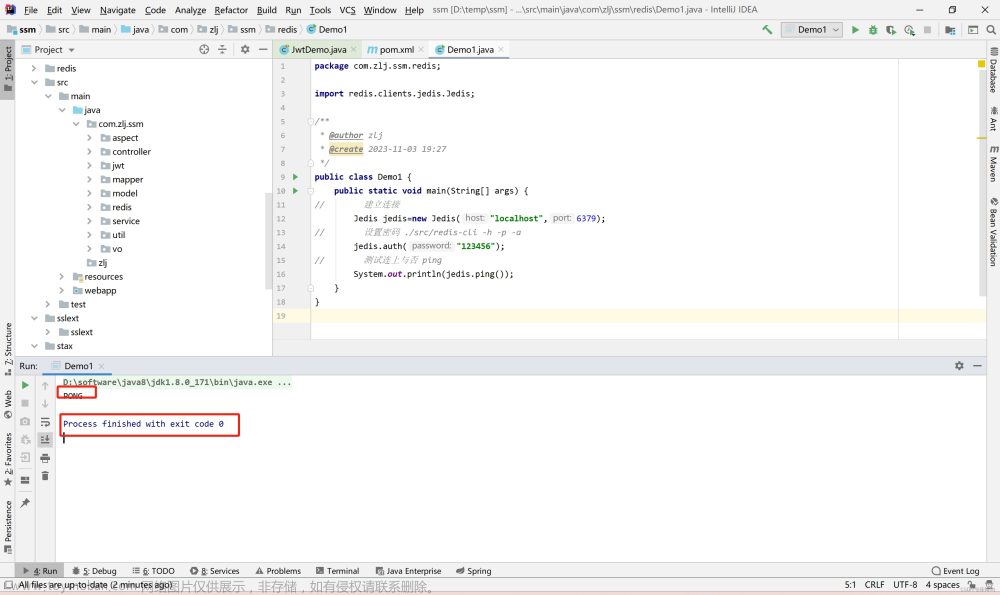Spring Boot 中的 Redis 数据操作配置和使用
Redis(Remote Dictionary Server)是一种高性能的开源内存数据库,用于缓存、消息队列、会话管理和数据存储。在Spring Boot应用程序中,Redis被广泛用于各种用例,包括缓存、持久性存储和分布式锁。本文将探讨如何在Spring Boot中配置和使用Redis,包括数据操作和常见用例。

配置 Spring Boot 项目以使用 Redis
要在Spring Boot项目中使用Redis,首先需要添加相关依赖和配置。以下是在pom.xml中添加Redis依赖项的示例:
<dependency>
<groupId>org.springframework.boot</groupId>
<artifactId>spring-boot-starter-data-redis</artifactId>
</dependency>
Spring Boot的spring-boot-starter-data-redis依赖项将自动包含所需的Redis客户端库(通常是Lettuce或Jedis)和其他必要的依赖项。您还需要配置Redis连接信息。在application.properties或application.yml中添加以下配置:
spring.redis.host=127.0.0.1 # Redis 服务器地址
spring.redis.port=6379 # Redis 服务器端口
这些配置将告诉Spring Boot应用程序如何连接到Redis服务器。根据您的环境,您可能需要添加其他配置,如认证信息或SSL支持。
使用 Spring Boot 进行 Redis 数据操作
一旦配置了Spring Boot项目以使用Redis,您可以开始使用Redis进行数据操作。Spring Boot提供了方便的注解驱动的方式来执行各种Redis操作,包括存储、检索、删除和过期设置。
存储数据
要将数据存储到Redis中,您可以使用@Service或@Repository注解将一个类声明为Spring组件,并使用@Autowired注解注入StringRedisTemplate或RedisTemplate bean。以下是一个示例:
import org.springframework.beans.factory.annotation.Autowired;
import org.springframework.data.redis.core.StringRedisTemplate;
import org.springframework.stereotype.Service;
@Service
public class RedisDataService {
@Autowired
private StringRedisTemplate stringRedisTemplate;
public void saveData(String key, String value) {
stringRedisTemplate.opsForValue().set(key, value);
}
}
在上述示例中,我们注入了StringRedisTemplate,并使用opsForValue().set()方法将键值对存储到Redis中。
检索数据
要检索存储在Redis中的数据,您可以使用opsForValue().get()方法。以下是一个示例:
public String getData(String key) {
return stringRedisTemplate.opsForValue().get(key);
}
删除数据
要删除Redis中的数据,您可以使用delete()方法。以下是一个示例:
public void deleteData(String key) {
stringRedisTemplate.delete(key);
}
设置过期时间
您还可以为存储在Redis中的数据设置过期时间,以便自动清理不再需要的数据。以下是一个示例:
public void saveDataWithTTL(String key, String value, long timeoutInSeconds) {
stringRedisTemplate.opsForValue().set(key, value, timeoutInSeconds, TimeUnit.SECONDS);
}
在上述示例中,timeoutInSeconds参数表示数据的过期时间(以秒为单位)。
Redis 哨兵和集群配置
在生产环境中,通常会使用Redis Sentinel(哨兵)或Redis Cluster来提高Redis的可用性和性能。Spring Boot提供了配置选项来支持这些部署模式。
使用 Redis Sentinel
要配置Spring Boot项目以使用Redis Sentinel,您需要在application.properties或application.yml中添加以下配置:
spring.redis.sentinel.master=my-master # 哨兵主节点名称
spring.redis.sentinel.nodes=host1:port1,host2:port2,host3:port3 # 哨兵节点列表
这些配置将告诉Spring Boot如何连接到Redis Sentinel,并自动发现主节点和从节点。
使用 Redis Cluster
要配置Spring Boot项目以使用Redis Cluster,您需要在application.properties或application.yml中添加以下配置:
spring.redis.cluster.nodes=host1:port1,host2:port2,host3:port3 # Redis Cluster 节点列表
这些配置将告诉Spring Boot如何连接到Redis Cluster。
使用 Spring Boot 进行常见 Redis 用例
除了基本的存储、检索、删除和过期设置之外,Redis还支持各种高级用例,如缓存、计数、发布/订阅、分布式锁等。以下是一些常见的Redis用例和Spring Boot的实现示例。
使用 Redis 进行缓存
Spring Boot提供了内置的缓存支持,可以轻松集成Redis作为缓存提供程序。要启用缓存支持,只需在Spring Boot应用程序的配置类上添加@EnableCaching注解,并在application.properties或application.yml中配置Redis连接信息。以下是一个示例:
import org.springframework.cache.annotation.EnableCaching;
import org.springframework.context.annotation.Configuration;
@Configuration
@EnableCaching
public class CacheConfig {
// ...
}
在application.properties或application.yml中添加Redis配置:
spring.cache.type=redis
spring.redis.host=127.0.0.1
spring.redis.port=6379
然后,您可以在需要缓存的方法上使用@Cacheable注解
:
import org.springframework.cache.annotation.Cacheable;
import org.springframework.stereotype.Service;
@Service
public class CachedDataService {
@Cacheable("myCache")
public String getCachedData(String key) {
// 如果数据未缓存,将执行下面的方法并将结果存储到缓存
return fetchDataFromDataSource(key);
}
private String fetchDataFromDataSource(String key) {
// 从数据源获取数据
return "Data for " + key;
}
}
使用 Redis 进行计数
Redis是一个出色的计数器存储介质。您可以使用opsForValue().increment()方法递增或递减计数器的值。以下是一个示例:
public long incrementCounter(String key) {
return stringRedisTemplate.opsForValue().increment(key);
}
使用 Redis 发布/订阅
Redis支持发布/订阅模式,允许多个订阅者订阅特定的频道,以接收发布者发布的消息。Spring Boot通过StringRedisTemplate提供了简单的发布/订阅功能。以下是一个示例:
public void publishMessage(String channel, String message) {
stringRedisTemplate.convertAndSend(channel, message);
}
使用 Redis 进行分布式锁
分布式锁是在分布式系统中确保资源互斥访问的一种常见机制。Spring Boot提供了使用Redis实现分布式锁的功能。以下是一个示例:
public boolean acquireLock(String lockKey, String clientId, long expirationTime) {
Boolean lockAcquired = stringRedisTemplate.opsForValue().setIfAbsent(lockKey, clientId, expirationTime, TimeUnit.MILLISECONDS);
return lockAcquired != null && lockAcquired;
}
总结
Redis是一种功能强大的内存数据库,广泛用于Spring Boot应用程序中的各种用例。通过添加spring-boot-starter-data-redis依赖项,配置Redis连接信息,以及使用StringRedisTemplate或RedisTemplate进行数据操作,您可以轻松地将Redis集成到您的应用程序中。文章来源:https://www.toymoban.com/news/detail-725856.html
本文介绍了如何配置Spring Boot项目以使用Redis,执行基本的数据操作,以及如何应对常见的Redis用例,包括缓存、计数、发布/订阅和分布式锁。希望这篇文章对您有所帮助,让您更好地理解如何在Spring Boot中配置和使用Redis来实现各种功能。文章来源地址https://www.toymoban.com/news/detail-725856.html
到了这里,关于Spring Boot 中的 Redis 数据操作配置和使用的文章就介绍完了。如果您还想了解更多内容,请在右上角搜索TOY模板网以前的文章或继续浏览下面的相关文章,希望大家以后多多支持TOY模板网!








